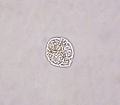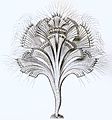Cercozoa
| Cercozoa | |
|---|---|

| |
| Cercomonas | |
| Scientific classification | |
| Domain: | Eukaryota |
| Clade: | Diaphoretickes |
| Clade: | SAR |
| Clade: | Rhizaria |
| Phylum: | Cercozoa Cavalier-Smith 1998[1] |
| Groups[4] | |
The Cercozoa are a group of single-celled eukaryotes. They lack shared morphological characteristics at the microscopic level,[5] being defined by molecular phylogenies of rRNA and actin or polyubiquitin.[6]
Characteristics
The group includes most amoeboids and flagellates that feed by means of filose pseudopods. These may be restricted to part of the cell surface, but there is never a true cytostome or mouth as found in many other protozoa. They show a variety of forms[4] and have proven difficult to define in terms of structural characteristics, although their unity is strongly supported by genetic studies. Cercozoa are closely related to Foraminifera and Radiolaria, amoeboids that usually have complex shells, and together with them form a supergroup called the Rhizaria.
Types
They are sometimes grouped by whether they are "filose" or "reticulose".[7]
Filose (subphylum Filosa)
The best-known Cercozoa are the euglyphids, filose amoebae with shells of siliceous scales or plates, which are commonly found in soils, nutrient-rich waters, and on aquatic plants. Some other filose amoebae produce organic shells, including the tectofilosids and Gromia. They were formerly classified with the euglyphids as the Testaceafilosia. This group is not monophyletic, but nearly all studied members fall in or near the Cercozoa, related to similarly shelled flagellates. Other notable filose cercozoans include the cercomonads, which are common soil flagellates.
Reticulose (subphylum Endomyxa)
Another important group placed here are the chlorarachniophytes, strange amoebae that form a reticulating net. They are set apart by the presence of chloroplasts, which apparently developed from an ingested green alga. They are bound by four membranes and still possess a vestigial nucleus, called a nucleomorph. As such, they have been of great interest to researchers studying the endosymbiotic origins of organelles.
Chlorarachniophytes are sometimes considered Filosa, rather than Endomyxa, while groups such as Gromia are considered Endomyxa.[8] Filosa is apparently a monophyletic group, but Endomyxa is paraphyletic.[9]
Ungrouped
In addition, three groups that are traditionally considered heliozoans belong here: the Heliomonadida, Desmothoracida, and Gymnosphaerida, which were recently grouped into the new class of Granofilosea.[7]
Finally, cercozoans include the Phaeodarea, marine protozoa that were previously considered radiolarians.
Classification
The exact composition and classification of the Cercozoa are still being worked out. A general scheme is:
| Class Chlorarachnea | Chlorarachniophyta |
| Class Proteomyxidea | Gymnophryida, Heliomonadida, Desmothoracida, Gymnosphaerida, etc. |
| Class Sarcomonadea | Cercomonadida |
| Class Imbricatea / Silicofilosea | Euglyphida and Thaumatomonadida |
| Class Thecofilosea | Tectofilosida and Cryomonadida |
| Class Phaeodarea | |
| Class Ebridea | Ebridea |
In addition two groups of parasites, the Phytomyxea and Ascetosporea, and the shelled amoeba Gromia may be basal Cercozoa, although some trees place them closer to the Foraminifera.
The spongomonads have been included here, but more recently have been considered Amoebozoa.[citation needed]
Some other small groups of protozoans are considered Cercozoa but are of uncertain placement, and it is likely many obscure genera will turn out to be cercozoans with further study.
Phylogeny
Phylogeny based on Bass et al. 2009,[7] Howe etal. 2011[10] and Silar 2016.[11]
Cercozoa |
In 2019, Cercozoa were recognized as sister to Retaria in Rhizaria.[12]
Taxonomy
Phylum Cercozoa[10][11][13][14][15]
- Family ?Gymnophrydiidae
- Family ?Gymnophryidae Mikrjukov & Mylnikov 1996
- Family ?Rhizoplasmidae Cavalier-Smith & Bass 2009
- Order ?Gymnosphaerida Poche 1913 emend. Mikrjukov 2000 [Axoplasthelida]
- Family Gymnosphaeridae Poche 1913 [Hedraiophryidae; Gymnidae; Wagnerellidae Poche 1913]
- Clade Marimyxia Cavalier-Smith 2017
- Order Reticulosida Cavalier-Smith 2003 emend. Bass et al. 2009
- Family Filoretidae Cavalier-Smith & Bass 2009
- Class Gromiidea Cavalier-Smith 2003
- Order Gromiida Claparède & Lachmann 1856 s.s.
- Class Ascetosporea Desportes & Ginsburger-Vogel, 1977 emend. Cavalier-Smith 2009 [Aplosporidies Caullery & Mesnil, 1899; Stellatosporea; Ascetospora Sprague 1979]
- Order Claustrosporida Cavalier-Smith 2003
- Order Paradiniida Cavalier-Smith 2009
- Order Mikrocytida Hartikainen et al. 2014
- Order Paramyxida Chatton 1911 [Paramyxea Chatton 1911; Paramyxidea Chatton 1911; Paramyxa]
- Order Haplosporida Caullery & Mesnil 1899 [Balanosporida Sprague, 1979; Haplosporidia Hall, 1953; Haplosporea Caullery 1953; Haplospora Margulis & Schwartz, 1998; Haplosporidiidea Poche, 1913; Haplosporidies Caullery and Mesnil, 1905]
- Order Reticulosida Cavalier-Smith 2003 emend. Bass et al. 2009
- Class Phytomyxea Engler & Prantl 1897 em. Cavalier-Smith 1993 [Phytomyxinae Engler & Prantl, 1897; Phytomyxinea Poche, 1913]
- Order Phagomyxida Cavalier-Smith 1993
- Order Plasmodiophorida Cook 1928 em. Cavalier-Smith 1993
- Class Vampyrellidea Cavalier-Smith 2017 [Cristivesiculatia Page 1987 stat. nov. Cavalier-Smith 1993]
- Order Vampyrellida West 1901 emend. Hess et al. 2012 [Aconchulinida de Saedeleer 1934 emend. Bass et al. 2009; Cristivesiculatida Page 1987]
- Subphylum Filosa Leidy 1879 emend. Cavalier-Smith 2003
- Class Skiomonadea Cavalier-Smith 2012
- Order Tremulida Cavalier-Smith & Howe 2011
- Class Chlorarachnea Hibberd & Norris 1984 [Chlorarachniophyceae Hibberd & Norris 1984; Chlorarachniophyta Hibberd & Norris 1984; Chlorarachnia Cavalier-Smith 1993]
- Order Minorisida Cavalier-Smith 2017
- Order Chlorarachniida Hibberd & Norris 1984 [Chlorarachniales; Chlorarachniophida]
- Class Granofilosea Cavalier-Smith & Bass 2009
- Family ?Microgromiidae De Saedeleer 1934
- Order ?Axomonadida [Exonucleoaxoplastiales]
- Order Desmothoracida Honigberg et al. 1964 [Cryptaxohelida; Desmothoraca Hertwig & Lesser 1874]
- Order Cryptofilida Cavalier-Smith & Bass 2009
- Order Limnofilida Cavalier-Smith & Bass 2009
- Order Leucodictyida Cavalier-Smith 1993 emend. 2003
- Infraphylum Monadofilosa Cavalier-Smith 1997 [Eoglissa Cavalier-Smiths 2012]
- Family ?Katabiidae Cavalier-Smith 2012
- Family ?Krakenidae Dumack, Mylnikov & Bonkowski 2017
- Order ?Pseudodimorphida
- Class Helkesea Cavalier-Smith 2017
- Order Ventricleftida Cavalier-Smith 2011
- Order Helkesida Cavalier-Smith 2017 [Sainourida]
- Order Cercomonadida Poche 1913 emend. Karpov et al. 2006
- Class Metromonadea Cavalier-Smith 2007 s.s.
- Order Metromonadida Bass & Cavalier-Smith 2004
- Order Metopiida Cavalier-Smith 2003
- Clade Glissomonadida-Pansomonadida
- Order Glissomonadida Howe & Cavalier-Smith 2009 emend. Hess et al. 2013
- Order Pseudosporida Hibberd 1983 sensu Cavalier-Smith 1993
- Order Dimorphida Siemensma 1991 [Endonucleoplastiales]
- Order Pansomonadida Vickerman 2005
- Class Silicofilosea Adl et al. 2005 emend. Adl et al. 2012 [Imbricatea Cavalier-Smith 2011]
- Order Perlofilida Cavalier-Smith 2012
- Order Spongomonadida Hibberd 1983 emend. Karpov 1990
- Order Zoelucasida Cavalier-Smith 2014
- Order Rotosphaerida Rainer 1968
- Order Thaumatomonadida Shirkina 1987
- Order Discocelida Cavalier-Smith 1997
- Order Discomonadida
- Order Variglissida
- Order Marimonadida Cavalier-Smith & Bass 2011 [Auranticordida]
- Order Euglyphida Copeland 1956 emend. Cavalier-Smith 1997 [Euglyphina Bovee 1985]
- Class Thecofilosea Cavalier-Smith 2003 emend. Cavalier-Smith 2011 [Tripylea Hertwig 1879]
- Order Hemimastigida Foissner, Blatterer & Foissner 1988 [Hemimastigophora Foissner, Blatterer & Foissner 1988 sensu Cavalier-Smith 1993; Hemimastigea Foissner, Blatterer & Foissner 1988; Hemimastigidea]}
- Order Matazida Cavalier-Smith 2012
- Order Ebriida Poche [Ebriidea Lemmermann 1901 emend. Deflandre 1936; Ebiophyta; Ebriacea Lemmermann 1901; Ebriophyceae Loeblich 1970; Ebriales Honigsberg 1964; Stereotestales]
- Order Cryomonadida Cavalier-Smith 1993 [Cryothecomonadea; Cryothecomonadida]
- Order Tectofilosida
- Order Eodarida Cavalier-Smith 2012 [Phaeodinia]
- Order Opaloconchida Cavalier-Smith 2012
- Class Skiomonadea Cavalier-Smith 2012
-
Cercomonas sp. (Cercozoa: Cercomonadida
-
Ebria sp. (Cercozoa: Ebridea)
-
Rhipidodendron sp. (Cercozoa: Spongomonadea)
-
Euglypha sp. (Cercozoa: Euglyphida)
-
Phaeodarians (Cercozoa: Phaeodarea)
-
Clathrulina elegans (Cercozoa: Granofilosea: Desmothoracida)
-
Chlorarachnion sp. (Cercozoa: (Chlorarachniophyta)
-
Vampyrella sp. (Cercozoa: Vampyrellidae)
-
Powdery scab (Cercozoa: Plasmodiophorida)
Recently an orphan protist Quadricilia rotundata finally finds fts phylogenetic home in Cercozoa.[16]
References
- ^ Cavalier-Smith, T. (1998). "A revised six-kingdom system of life". Biological Reviews of the Cambridge Philosophical Society. 73 (3): 203–266. doi:10.1111/j.1469-185X.1998.tb00030.x. PMID 9809012.
- ^ Nikolaev SI, Berney C, Fahrni JF, et al. (May 2004). "The twilight of Heliozoa and rise of Rhizaria, an emerging supergroup of amoeboid eukaryotes". Proc. Natl. Acad. Sci. U.S.A. 101 (21): 8066–71. doi:10.1073/pnas.0308602101. PMC 419558. PMID 15148395.
- ^ Hoppenrath, M.; Leander B.S. (2006). "Ebriid phylogeny and the expansion of the Cercozoa". Protist. 157 (3): 279–90. doi:10.1016/j.protis.2006.03.002. PMID 16730229.
- ^ a b Cavalier-Smith T, Chao EE (October 2003). "Phylogeny and classification of phylum Cercozoa (Protozoa)" (PDF). Protist. 154 (3–4): 341–58. doi:10.1078/143446103322454112. PMID 14658494.
- ^ Chantangsi, C. (2009). Comparative morphology and molecular evolution of marine interstitial cercozoans. PhD thesis. University of British Columbia.
- ^ "SYSTEMATIC BIOLOGY: CERCOZOA". Retrieved 2009-03-28.
- ^ a b c Bass D, Chao EE, Nikolaev S, et al. (February 2009). "Phylogeny of Novel Naked Filose and Reticulose Cercozoa: Granofilosea cl. n. and Proteomyxidea Revised". Protist. 160 (1): 75–109. doi:10.1016/j.protis.2008.07.002. PMID 18952499.
- ^ "Cercozoa". Retrieved 2009-05-21.
- ^ Nakamura, Yasuhide; Imai, Ichiro; Yamaguchi, Atsushi; Tuji, Akihiro; Not, Fabrice; Suzuki, Noritoshi (2015). "Molecular Phylogeny of the Widely Distributed Marine Protists, Phaeodaria (Rhizaria, Cercozoa)". Protist. 166 (3): 363–373. doi:10.1016/j.protis.2015.05.004.
- ^ a b Howe; et al. (2011), "Novel Cultured Protists Identify Deep-branching Environmental DNA Clades of Cercozoa: New Genera Tremula, Micrometopion, Minimassisteria, Nudifila, Peregrinia", Protist, 162 (2): 332–372, doi:10.1016/j.protis.2010.10.002, PMID 21295519
- ^ a b Silar, Philippe (2016), "Protistes Eucaryotes: Origine, Evolution et Biologie des Microbes Eucaryotes", HAL Archives-ouvertes: 1–462
- ^ Irwin, Nicholas A.T.; Tikhonenkov, Denis V.; Hehenberger, Elisabeth; Mylnikov, Alexander P.; Burki, Fabien; Keeling, Patrick J. (2019-01-01). "Phylogenomics supports the monophyly of the Cercozoa". Molecular Phylogenetics and Evolution. 130: 416–423. doi:10.1016/j.ympev.2018.09.004. ISSN 1055-7903. PMID 30318266.
- ^ Adl; et al. (28 September 2012), "The Revised Classification of Eukaryotes" (PDF), Journal of Eukaryotic Microbiology, 59 (5): 429–493, doi:10.1111/j.1550-7408.2012.00644.x, PMC 3483872, PMID 23020233
- ^ Ruggiero; et al. (2015), "Higher Level Classification of All Living Organisms", PLoS ONE, 10 (4): e0119248, Bibcode:2015PLoSO..1019248R, doi:10.1371/journal.pone.0119248, PMC 4418965, PMID 25923521
{{citation}}: CS1 maint: unflagged free DOI (link) - ^ Cavalier-Smith, Thomas (5 September 2017). "Kingdom Chromista and its eight phyla: a new synthesis emphasising periplastid protein targeting, cytoskeletal and periplastid evolution, and ancient divergences". Protoplasma. 255 (1): 297–357. doi:10.1007/s00709-017-1147-3. PMC 5756292. PMID 28875267.
- ^ An Orphan Protist Quadricilia rotundata Finally Finds Its Phylogenetic Home in Cercozoa Article in Journal of Eukaryotic Microbiology · January 2018 DOI: 10.1111/jeu.12502 Akinori Yabuki at Japan Agency for Marine-Earth Science Technology
External links
- Tree of Life Cercozoa
- phylogeny of Phaeodarea









